New Testament Commentaries, 27 vols. (Anchor Yale Bible Commentary | AYBC)
Digital Logos Edition
Overview
The Anchor Yale Bible is a fresh approach to the world’s greatest classic—the Bible. This prestigious commentary series represents the pinnacle of biblical scholarship, drawing from the wisdom and resources of Protestant, Catholic, and Jewish scholars from around the world. A book-by-book translation and exegesis of the New Testament that includes 27 volumes, this vast commentary series makes available all the significant historical and linguistic knowledge which bears on the interpretation of the Bible.
These massive commentaries have set the standard for biblical scholarship for decades—marking the beginning of a new era—by making the Bible accessible to modern readers. The Anchor Yale Bible aims to arrive at the meaning of biblical literature through exact translation and extended exposition, and to reconstruct the ancient setting of the biblical story, as well as the circumstances of its transcription and the characteristics of its transcribers. These commentaries are written with the most exacting standards of scholarship, reflecting the highest technical accomplishment. They are accessible for laypersons, and vital for sermon preparation, research, and advanced study of the Bible.
Due to rights issues, the commentary on Matthew is not included in this collection and is no longer available for purchase.

- Offers original translations, including alternative translations, annotations, and variants
- Details the historical, critical, and literary evolution of the text
- Provides a detailed outline of each book
- Discusses the text with verse-by-verse commentary
- Analyzes various interpretive approaches and the process of canonicity
- Enhances study with apps, photographs, and illustrations
- Presents the reader with historical background, including analysis of authorship and dating
- Implements an extensive bibliography of primary and secondary literature
The Anchor Yale Bible Series, previously the Anchor Bible Series, is a renowned publishing program that for more than 50 years has produced books devoted to the latest scholarship on the Bible and biblical topics. Yale University Press, having acquired this prestigious series in 2007, is now proud to offer all previously published Anchor Bible titles as well as new books—more than 115 titles in all. Many more volumes are in progress as the AYB Editorial Board, under the direction of General Editor John J. Collins, vigorously pursues the goal of bringing to a wide audience the most important new ideas, the latest research findings, and the clearest possible analysis of the Bible. Widely recognized as the flagship of American biblical scholarship, the Anchor Yale Bible Series is comprised of:
- Anchor Yale Bible Commentary (AYBC), a book-by-book translation and exegesis of the Hebrew Bible, the New Testament, and the Apocrypha
- Anchor Yale Bible Dictionary (AYBD), a state-of-the-art dictionary in six volumes with more than 6,000 entries from 800 international scholars
- The Anchor Yale Bible Reference Library, containing more than 40 volumes by foremost scholars from a variety of religious backgrounds who focus on broad biblical themes
- Title: Anchor Yale Bible Commentary | AYBC: New Testament (27 vols.)
- Publisher: Yale University Press
- Series: Anchor Yale Bible
- Volumes: 27
- Pages: 17,241
- Resource Types: Commentaries
- Topic: New Testament
- Resource ID: {2647A8DE-7078-4D40-BF8F-A5B018D59133}
- Mark 1–8 by Joel Marcus
- Mark 8–16 by Joel Marcus
- The Gospel According to Luke I–IX by Joseph A. Fitzmyer
- The Gospel According to Luke X–XXIV by Joseph A. Fitzmyer
- The Gospel According to John I–XII by Raymond E. Brown
- The Gospel According to John, XIII–XXI by Raymond E. Brown
- The Acts of the Apostles by Joseph A. Fitzmyer
- Romans by Joseph A. Fitzmyer
- First Corinthians by Joseph A. Fitzmyer
- I Corinthians by William F. Orr and James A. Walther
- II Corinthians by Victor P. Furnish
- Galatians by J. Louis Martyn
- Ephesians 1–3 by Markus Barth
- Ephesians 4–6 by Markus Barth
- Philippians by John Reumann
- Colossians by Markus Barth and Helmut Blanke
- The Letters to the Thessalonians by Abraham J. Malherbe
- The First and Second Letters to Timothy by Luke T. Johnson
- Letter to Titus by Jerome D. Quinn
- Letter to Philemon by Joseph A. Fitzmyer
- Hebrews by Craig R. Koester
- The Letter of James by Luke T. Johnson
- 1 Peter by John H. Elliott
- 2 Peter, Jude by Jerome H. Neyrey
- Epistles of John by Raymond E. Brown
- Revelation by J. Massyngberde Ford
- Revelation: A New Translation with Introduction and Commentary by Craig Koester
This title is included in the following collections
You can save when you purchase this product as part of a collection.
Anchor Yale and Sacra Pagina N...
$1,781.55$1,424.99Verbum 10 Acadêmico (Português...
$1,697.99$1,697.99Biblioteca Colecionador 2025
$3,499.99$2,449.99Logos 8 Lutheran Diamond Legac...
$2,999.99$2,999.99
- $2,999.99
- $2,999.99
- $2,999.99
- $4,749.99$3,324.99
- $3,374.99
- $4,749.99$3,562.49
- $4,749.99$3,562.49
- $4,749.99$3,562.49
- $4,749.99$3,562.49
- $4,899.99$3,674.99
- $3,999.99
- $5,354.82$4,083.99
- $6,452.68$4,499.99
- $7,698.39$4,599.99
- $4,749.99
- $4,749.99
- $4,749.99
- $4,749.99
- $4,749.99
- $4,749.99
- $4,749.99
- $4,749.99
- $7,749.99
- $7,749.99
- $10,999.99$8,249.99
- $11,399.99
- $11,399.99
- $11,399.99
- $23,999.99$17,999.99
- $21,749.99
- $24,999.99
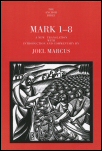
Although it appears second in the New Testament, Mark is generally recognized as the first Gospel to be written. Captivating non-stop narrative characterizes this earliest account of the life and teachings of Jesus. In the first installment of his two volume commentary on Mark, New Testament scholar Joel Marcus recaptures the power of Mark’s enigmatic narrative and capitalizes on its lively pace to lead readers through familiar and not-so-familiar episodes from the ministry of Jesus.
As Marcus points out, the Gospel of Mark can only be understood against the backdrop of the apocalyptic atmosphere of the Jewish rebellion of 66–73 AD, during which the Roman army destroyed the temple in Jerusalem. While the Jewish revolutionaries believed that the war was “the beginning of the end” and that a messianic redeemer would soon appear to lead his people to victory over their human enemies (the Romans) and cosmic foes (the demons), for Mark the redeemer had already come in the person of Jesus. Paradoxically, however, Jesus had won the decisive holy-war victory when he was rejected by his own people and executed on a Roman cross.
The student of two of this generation’s most respected Bible scholars, Raymond E. Brown and J. Louis Martyn, Marcus helps readers understand the history, social customs, economic realities, religious movements, and spiritual and personal circumstances that made Jesus who he was. Challenging to scholars and enlightening to lay people, Mark 1–8 is an invaluable tool for anyone reading the Gospel story.
Joel Marcus is professor of New Testament and Christian origins at Boston University School of Theology, having previously taught at the University of Glasgow and Princeton Theological Seminary. Aside from his many scholarly publications in prestigious journals such as the Journal of Biblical Literature, Catholic Biblical Quarterly, and New Testament Studies, he is the author of The Way of the Lord: Christological Exegesis of the Old Testament in the Gospel of Mark, available from Logos as part of Studies in Jesus and the Gospels (23 vols.).
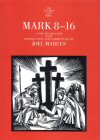
In the final nine chapters of the Gospel of Mark, Jesus increasingly struggles with his disciples’ incomprehension of his unique concept of suffering Messiahship and with the opposition of the religious leaders of his day. The Gospel recounts the events that led to Jesus’ arrest, trial, and crucifixion by the Roman authorities, concluding with an enigmatic ending in which Jesus’ resurrection is announced but not displayed.
In this volume, New Testament scholar Joel Marcus offers a new translation of Mark 8–16. He situates the narrative within the context of first-century Palestine and the larger Greco-Roman world; within the political context of the Jewish revolt against the Romans (66–73 AD); and within the religious context of the early church’s sometimes rancorous engagement with Judaism, pagan religion, and its own internal problems. For religious scholars, pastors, and interested lay people alike, the book provides an accessible and enlightening window on the second of the canonical Gospels.
Joel Marcus is professor of New Testament and Christian origins at Boston University School of Theology, having previously taught at the University of Glasgow and Princeton Theological Seminary. Aside from his many scholarly publications in prestigious journals such as the Journal of Biblical Literature, Catholic Biblical Quarterly, and New Testament Studies, he is the author of The Way of the Lord: Christological Exegesis of the Old Testament in the Gospel of Mark, available from Logos as part of Studies in Jesus and the Gospels (23 vols.).
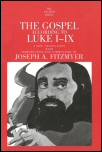
In this first of two volumes on the Gospel according to Luke, Joseph A. Fitzmyer provides an exhaustive introduction, a definitive new translation, and extensive notes and commentary on Luke’s Gospel. Fitzmyer brings to the task his mastery of ancient and modern languages, his encyclopedic knowledge of the sources, and his intimate acquaintance with the questions and issues occasioned by the third Synoptic Gospel.
Luke’s unique literary and linguistic features, its relation to the other Gospels and the book of Acts, and its distinctive theological slant are discussed in detail by the author. The Jesus of Luke’s Gospel speaks to the Greco-Roman world of first-century Christians, giving the followers of Jesus a reason for remaining faithful. Fitzmyer’s exposition of this Gospel helps modern-day Christians hear the good news afresh.
Joseph A. Fitzmyer is a Jesuit priest and professor emeritus at the Catholic University of America. A past president of both the Society of Biblical Literature and the Catholic Biblical Association, and co-editor of The New Jerome Biblical Commentary, Fitzmyer has written The Aramaic Inscriptions of Sefire and The Genesis Apocryphon of Qumran Cave 1 (1Q20): A Commentary, available from Logos in the Northwest Semitic Collection (7 vols.), and A Manual of Palestinian Aramaic Texts.
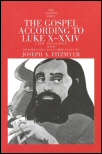
In this second of two volumes on the Gospel of Luke, beginning with chapter 10, Joseph A. Fitzmyer builds on the exhaustive introduction, definitive new translation, and extensive notes and commentary presented in his first volume. Fitzmyer brings to the task his mastery of ancient and modern languages, his encyclopedic knowledge of the sources, and his intimate acquaintance with the questions and issues raised by the third Synoptic Gospel.
In “joining the spirit to the letter” and scholarship to faith, this two volume commentary on Luke has, as the Journal of Biblical Literature predicted, “rapidly and deservedly become the standard work on Luke.” Luke’s unique literary and linguistic features, its relation to the other Gospels and the book of Acts, and its distinctive theological slant are discussed in detail by the author. The Jesus of Luke’s Gospel speaks to the Greco-Roman world of first-century Christians, giving the followers of Jesus a reason for remaining faithful. Fitzmyer’s exposition of Luke helps modern-day Christians hear the Good News afresh and understand it like never before.
Joseph A. Fitzmyer is a Jesuit priest and professor emeritus at the Catholic University of America. A past president of both the Society of Biblical Literature and the Catholic Biblical Association, and co-editor of The New Jerome Biblical Commentary, Fitzmyer has written The Aramaic Inscriptions of Sefire and The Genesis Apocryphon of Qumran Cave 1 (1Q20): A Commentary, available from Logos in the Northwest Semitic Collection (7 vols.), and A Manual of Palestinian Aramaic Texts.
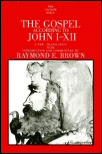
The Gospel According to John I–XII
- Author: Raymond E. Brown, S.S.
- Publisher: Yale University Press
- Publication Date: 1995
- Pages: 688
In the first volume of Raymond E. Brown’s magisterial commentary on the Gospel According to John, all of the major Johannine questions—of authorship, composition, dating, the relationship of John to the Synoptics (Mark and Luke)—are discussed. The important theories of modern biblical scholarship concerning John are weighed against the evidence given in the text and against prevailing biblical research. In sum, what is attempted is a synthesis of the major scholarly insights that bear on the fourth Gospel.
The translation—as Raymond E. Brown states at the outset—strives not for any formal beauty but rather for an accurate and contemporary version: “the simple, everyday Greek of the Gospel has been rendered into the ordinary American English of today.” The result is a translation that will strike the reader with uncommon immediacy.
Brown also analyzes, in the appendixes, the meaning, use, and frequency of certain key words and phrases that occur in John, and examines the differences between the Johannine and Synoptic treatments of the miracle stories.
The chapters of the Gospel translated here (1–12) comprise the prologue, which opens with the famous “In the beginning was the Word,” and the Book of Signs, an account of the miracles of Jesus and of his ministry.
Raymond E. Brown was, throughout his illustrious career, internationally regarded as the dean of New Testament scholars. He was Auburn Distinguished Professor Emeritus of Biblical studies at Union Theological Seminary in New York City. In addition to his commentary on John in the Anchor Yale Bible series, he has also authored more than 35 books.
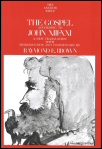
John 13–21 comprises the Book of Glory (describing the Last Supper, the Passion, and the appearances of the risen Jesus) and the epilogue to the Gospel. This commentary includes a special appendix on the Paraclete, in which Raymond E. Brown examines in detail the role of the Holy Spirit. Whether discussing John’s version of miracle stories found in the other Gospels, explaining the meaning of obscure Greek words, or showing the relevance of Jesus’ words and deeds, Raymond E. Brown speaks to scholars and laypeople alike.
Raymond E. Brown was, throughout his illustrious career, internationally regarded as the dean of New Testament scholars. He was Auburn Distinguished Professor Emeritus of Biblical studies at Union Theological Seminary in New York City. In addition to his commentary on John in the Anchor Yale Bible series, he has also authored more than 35 books.
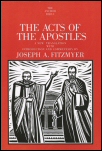
For anyone interested in the origins of Christianity, Joseph A. Fitzmyer’s The Acts of the Apostles is indispensable. Beginning with the ascension of Christ into heaven, and ending with Paul proclaiming the kingdom of God from a prison in Rome, this New Testament narrative picks up where the Gospel of Luke left off. The Acts of the Apostles is indeed a journey of nearly epic proportions—and one that requires a guide as adept as Fitzmyer.
Since Acts was most likely written by the same person who composed the Gospel of Luke, it is only fitting that the Anchor Yale Bible commentaries on these New Testament books should be written by the same author. With The Acts of the Apostles, Fitzmyer gives readers the long-awaited companion to his two volume commentary on the Gospel of Luke.
The four Gospels recount the life and teachings of Jesus, but only the book of the Acts of the Apostles tells the story of what happened after Jesus’ departure. In this second of Luke’s two-volume work, he picks up with Jesus saying farewell to his followers; then Luke tells the fast-paced story of the birth and growth of the early church. This narrative reads like a major breaking news story, with the apostles Peter and Paul as the main characters.
The interpretation of Acts requires a scholar of the highest quality. As he demonstrates in The Acts of the Apostles, Joseph Fitzmyer not only is up to the task but establishes once again why he is ranked among the world’s top biblical scholars. Far from being a rehash of old ideas and well-rehearsed theories, Fitzmyer’s commentary distinguishes itself as the capstone of his career, with a new synthesis of all the relevant data from the Roman world to the present. He provides a thorough introduction to the background, text, and context of the book, as well as chapter-by-chapter notes and comments in which are offered insights and answers to questions that have long plagued preachers and parishioners, teachers and students.
Joseph A. Fitzmyer is a Jesuit priest and professor emeritus at the Catholic University of America. A past president of both the Society of Biblical Literature and the Catholic Biblical Association, and co-editor of The New Jerome Biblical Commentary, Fitzmyer has written The Aramaic Inscriptions of Sefire and The Genesis Apocryphon of Qumran Cave 1 (1Q20): A Commentary, available from Logos in the Northwest Semitic Collection (7 vols.), and A Manual of Palestinian Aramaic Texts.
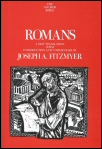
Outside of the Gospels themselves, there is no single Christian document whose influence has been greater than Paul’s epistle to the Romans. Its explosive character has changed lives—Augustine’s, Martin Luther’s, Karl Barth’s, to name a few—and precipitated revolutions.
This full-scale commentary deals with the most important issues of the early Christian church. And it is through the eyes of the apostle Paul, the major figure of this period, that we see dominant motifs and themes, the theological essentials of the Christian faith. Who better than the once pious Jew, converted to the Christian cause, to tell the reader about the early struggles with Judaism, the reluctant yet nurturing mother of this new community of faith?
This volume is aimed primarily at Christians, because the letter to the Romans is a part of their canon of Holy Scripture. But it is equally valuable for all those who have an interest in learning about one of the most important letters ever written by anyone, and in understanding the world-shaking movement of which it was an essential part, and to which it gave powerful impetus.
Joseph A. Fitzmyer is a Jesuit priest and professor emeritus at the Catholic University of America. A past president of both the Society of Biblical Literature and the Catholic Biblical Association, and co-editor of The New Jerome Biblical Commentary, Fitzmyer has written The Aramaic Inscriptions of Sefire and The Genesis Apocryphon of Qumran Cave 1 (1Q20): A Commentary, available from Logos in the Northwest Semitic Collection (7 vols.), and A Manual of Palestinian Aramaic Texts.
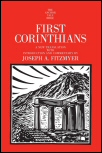
This new translation of First Corinthians includes an introduction and extensive commentary that has been composed to explain the religious meaning of this Pauline epistle. Joseph A. Fitzmyer discusses all the usual introductory problems associated with the epistle, including issues of its authorship, time of composition, and purpose, and he also presents a complete outline.
The author analyzes the epistle, pericope-by-pericope, discussing the meaning of each one in a comment and explaining details in the notes. The book supplies a bibliography on the various passages and problems for readers who wish to investigate further, and useful indexes complete the volume. First Corinthians will be of interest to general readers who wish to learn more about the Pauline letters, and also to pastors, college and university teachers, graduate students studying the Bible, and professors of biblical studies.
Joseph A. Fitzmyer is a Jesuit priest and professor emeritus at the Catholic University of America. A past president of both the Society of Biblical Literature and the Catholic Biblical Association, and co-editor of The New Jerome Biblical Commentary, Fitzmyer has written The Aramaic Inscriptions of Sefire and The Genesis Apocryphon of Qumran Cave 1 (1Q20): A Commentary, available from Logos in the Northwest Semitic Collection (7 vols.), and A Manual of Palestinian Aramaic Texts.
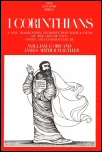
St. Paul’s 1 Corinthians stands as one of the Bible’s greatest masterpieces and certainly one of the greatest contributions to Christian theology. The epistle “to the church which is in Corinth . . . ” addresses itself to the basic tenets of Christian faith as well as down-to-earth matters of moral conduct and standards of Christian living, including such topics as speaking in tongues, the resurrection, the Lord’s Supper, and the problems of marriage. This letter also includes Paul’s memorable definition of Christian love.
The man who laid the foundations of Christian theology remains important not only for what he taught, but for who he was. Professors William F. Orr and James A. Walther ask—and answer—“What kind of man was Paul?” in their own extended introductory biography of the man: a look at his life, his ministry, and his beliefs.
William F. Orr is professor emeritus of New Testament at Pittsburgh Theological Seminary.
James Arthur Walther is associate professor of New Testament at Pittsburgh Theological Seminary.
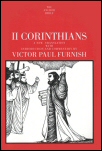
II Corinthians
- Author: Victor P. Furnish
- Publisher: Yale University Press
- Publication Date: 2005
- Pages: 648
Nothing speaks more highly for a commentary than how valuable it is to pastors and scholars, students, and interested readers. By all accounts, Victor Paul Furnish’s commentary on II Corinthians has become the standard by which others are judged. In addition, Furnish has “accomplished a difficult task with remarkable skill and apparent ease” (Biblical Theology Bulletin), and has given us “one of [the Anchor Yale Bible’s] finest studies” (Catholic Biblical Quarterly). In the internationally renowned tradition of the Anchor Yale Bible series, this commentary is an excellent and indispensable tool for biblical study.
Scholars rarely possess both the gift of academic excellence and the ability to communicate their expertise in an extremely readable fashion; but Furnish succeeds admirably with the right balance of scholarship and practical application, offered in the most accessible prose. With a mastery of primary languages and sources, and a lucid discussion of the first-century context of Paul’s second letter to the Corinthians, the reader enters the worldview of the original recipients of this hard-hitting letter. In the end, Furnish successfully navigates the maze of difficulties faced by the commentator and, thankfully, helps the general audience understand what II Corinthians says and means.
A quite superb commentary . . . everything that a good commentary should be
—Expository Times
Perhaps the definitive commentary on the letter in English
—Journal of the Evangelical Theological Society
Victor Paul Furnish is University Distinguished Professor of New Testament at the Perkins School of Theology, Southern Methodist University, in Dallas, Texas. His numerous publications on and contributions to Pauline studies set him apart as one of the premier New Testament scholars of our generation. Among his published works are contributions to Pauline Conversations in Context: Essays in Honor of Calvin J. Roetzel, available from Logos as part of the Library of New Testament Studies: JSNTS on Paul (17 vols.).
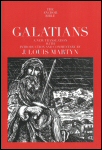
As the early church took shape in the mid-first century AD, a theological struggle of great consequence was joined between the apostle Paul and certain theologians who had intruded into the churches founded by the apostle in Galatia. Writing his letter to the Galatians in the midst of that struggle, Paul was concerned to find a way by which he could assert the radical newness of God’s act in Christ while still affirming the positive relation of that act to the solemn promise God had made centuries earlier to Abraham.
With the skill of a seasoned scholar and teacher, J. Louis Martyn enables us to take imaginary seats in the Galatian churches so that we may hear Paul’s words with the ears of the early Christians themselves. Listening in this manner, we begin to sense the dramatic intensity of the theological struggle, thus coming to understand the crucial distinctions between the theology of Paul and that of his opponents. We can therefore see why Galatians proved to be a momentous turning point in early Christianity: In this letter Paul preached the decisive and liberating newness of Christ while avoiding both the distortions of anti-Judaism and his opponents’ reduction of Christ to a mere episode in the epic of Israel’s history. Like the Galatians of Paul’s day, we can begin to hear what the apostle himself called “the truth of the gospel.”
Galatians successfully makes available all the significant historical and linguistic knowledge which bears on the interpretation of this important New Testament book. A personal letter written by Paul in the mid-first century to friends in the churches emerging in the region of Galatia, where it was circulated, Galatians is down to earth and pragmatic. This biblical book requires the modern reader to take a seat in one of the Galatian congregations, to listen to Paul’s letter with Galatian ears, and discern the contours of Paul’s theology. That is exactly what J. Louis Martyn makes possible in his marvelous commentary, with its careful translation and creative interpretation of Galatians. Though relatively brief, Paul’s letter is filled with complex theological and historical issues that demand a thorough treatment. Readers will not be disappointed in J. Louis Martyn’s sensitive handling of difficult passages, and all will be delighted to have a fresh translation that makes sense to our modern ears. All in all, this volume will stand out as a shining example of top notch scholarship written for the general reader.
J. Louis Martyn is Edward Robinson Professor Emeritus of Biblical theology at Union Theological Seminary in New York City. He has written books and scholarly articles on various New Testament topics, notably Theological Issues in the Letters of Paul.
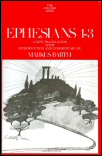
Encompassing the body of Pauline theology, Ephesians has been called “the crown of St. Paul’s writings,” yet both its authorship and addressees are the subject of continuing dispute. Through line-by-line examination of its vocabulary, its difficult style, its Qumran and Gnostic affinities, its parallels with and distinctions from the undisputed Pauline corpus, its use of the Old Testament, and its dialogue with orthodox and heretical Judaism, Markus Barth demonstrates that Paul was almost certainly the author. And, after exploring previous explications of this hymnic and admonitory epistle in detail, he concludes that it was intended for gentile Christians converted after Paul’s visits to Ephesus.
On this basis, Barth re-examines the relationship between Israel and the church, discounting the thesis that Ephesians suggests an “early Catholic,” or high-ecclesiastic or sacramental doctrine. Instead, he finds in this letter a statement of the social reconciliation which conditions the salvation of the individual. And re-evaluating the section describing the relation between husband and wife, he offers an alternative to the traditional notion that Paul degrades women or belittles their rights and their dignity.
Markus Barth, the son of Karl Barth, held the New Testament chair at the University of Basel, Switzerland, until his death in July 1994. He is co-author of The Letter to Philemon in the Eerdmans Critical Commentary Series (4 vols.).
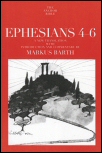
In these two volumes Markus Barth has followed the structure of Ephesians: upon the praise of God (chapters 1–3) are based the admonitions (chapters 4–6). But just as the epistle is an integral whole, so is the author’s commentary. Through his special understanding and love of the apostle Paul, Markus Barth reopens to modern man the ancient message of love, worship and joy.
Markus Barth, the son of Karl Barth, held the New Testament chair at the University of Basel, Switzerland, until his death in July 1994. He is co-author of The Letter to Philemon in the Eerdmans Critical Commentary Series (4 vols.).
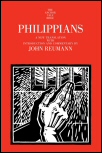
In Philippians John Reumann offers both classical approaches and new methods of understanding this New Testament book. With fresh commentary on the social world and rhetorical criticism, and a special focus on the contributions of the Philippian house churches to Paul’s work and early Christian mission, Reumann clarifies Paul’s attitudes toward and interactions with the Philippians.
Departing from traditional readings of Philippians in light of Acts, Reumann allows Paul to speak in his own right. His three letters from Ephesus shed new light on relationships, and we come to see how he approves some aspects of the dominant “culture of friendship” in Greco-Roman Philippi while disapproving of others. He seeks to help the Philippians discern how to be citizens of the heavenly kingdom and also Caesar’s state, though there is an undercurrent of “Christ vs. Caesar.” Scholars, students, and general readers alike will find much of interest in John Reumann’s deeply researched and insightful new volume.
John Reumann was Ministerium of Pennsylvania Professor of New Testament and Greek, emeritus, at Lutheran Theological Seminary, Philadelphia, where he taught for some 50 years. He studied and wrote on Philippians for over 30 years. He died in 2008.
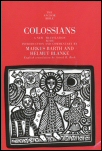
The Apostle Paul’s Letter to the Colossians offers a valuable and intimate glimpse into the life of a fledgling Christian community as it struggled to define Christian doctrine and theology. Paul was prompted to write to the Colossian assembly when he heard that “false teachers” had joined the congregation and were advocating dangerous, non-Christian practices. In an effort to appear superior, these heretical teachers were luring Christians to exercise asceticism, moral rigorism, and esoteric rituals—hallmarks of other “mystery” and pagan cults. In his passionate letter, Paul denounces these extreme and elitist practices and firmly defends a life in Christ. He proclaims that pure, simple worship of Christ alone is the most powerful statement of faith.
In their astute and lucid commentary, eminent New Testament scholars Markus Barth and Helmut Blanke re-create the turbulent age of the birth of Christianity and examine the myriad “outside” influences—from cold, rational Hellenistic philosophy to exclusive, ethereal Gnostic thought—that often threatened the evolution of Christian theology. Colossians not only provides a new and carefully balanced analysis of this pivotal New Testament text but also chronicles the development of Christian thought as it gradually spread throughout the Roman Empire.
Markus Barth, the son of Karl Barth, held the New Testament chair at the University of Basel, Switzerland, until his death in July 1994. He is co-author of The Letter to Philemon in the Eerdmans Critical Commentary Series (4 vols.).
Helmut Blanke was a student of Markus Barth’s and earned his ThD at the University of Basel. He is co-author of The Letter to Philemon in the Eerdmans Critical Commentary Series (4 vols.).
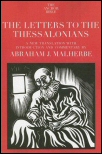
In AD 49, Paul traveled to Thessalonica, a major city in northern Greece, to preach the gospel. A small group of manual laborers responded positively to his message, resulting in the formation of a church. After spending less than three months with his converts, Paul left the city for southern Greece, ending up in Corinth, from where he wrote two letters to the Thessalonians four months or so after he had left them. These epistles are particularly valuable because they reveal the concerns of Christians new to the faith and Paul’s pastoral care as he guides them.
Abraham J. Malherbe vividly describes the social, cultural, religious, and philosophical contexts in which the Thessalonians lived, enabling us to better understand Paul’s missives. Detailed introductions to the letters, a new translation, and a lively, enlightening commentary make this an indispensable volume for scholar and layperson alike.
Abraham J. Malherbe is Buckingham Professor Emeritus of New Testament criticism and interpretation at Yale University. His many scholarly publications, like this present volume, are concerned with the literary and social dimensions of ancient literature and with Greco-Roman philosophy.

The letters of Paul to Timothy, one of his favorite delegates, often make for difficult reading in today’s world. They contain much that makes modern readers uncomfortable, and much that is controversial, including pronouncements on the place of women in the church and on homosexuality, as well as polemics against the so-called “false teachers.” They have also been of a source of questions within the scholarly community, where the prevailing opinion since the nineteenth century is that someone else wrote the letters and signed Paul’s name in order to give them greater authority.
Using the best of modern and ancient scholarship, Luke Timothy Johnson provides clear, accessible commentary that will help lay readers navigate the letters and better understand their place within the context of Paul’s teachings.
Luke Timothy Johnson is professor of New Testament at the Chandler School of Theology, Emory University, in Atlanta, Georgia. He is the author of The Letter of James in this series, The Writings of the New Testament, Reading Romans in Reading the New Testament Commentary (12 vols.), and of the bestseller The Real Jesus, as well as other books and numerous articles on the New Testament.
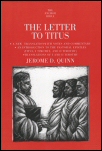
Letter to Titus
- Author: Jerome D. Quinn
- Publisher: Yale University Press
- Publication Date: 2005
- Pages: 384
The Letter to Titus, one of the three “Pastoral Epistles” of the New Testament, has over the last 20 years become the ground of intense controversy—theologically, sociologically, even politically. For this letter (like its companions, I and II Timothy) dates to a time when the apostles are gone and a new church leadership is evolving. In Titus we read instruction that is of continuing importance to the Christian faithful, touching on issues that are with us yet—leadership in the church and qualifications for authority; propriety of worship; the roles of women; the demands of the Christian ethic upon individuals; the relationship of the new followers of Christ with their Jewish contemporaries.
Jerome D. Quinn guides us ably through the shoals of contemporary controversy among scholars, dealing definitively with issues of authorship, place of origin, original audience, and the purpose of the Pastorals. More than this, he sets before us his integrated vision of these letters as the earliest anthology on the subject of pastoral leadership. The crowning achievement of a lifetime of admirable work in biblical studies, these translations and commentaries will stand as Quinn’s monument for generations to come.
Jerome D. Quinn, who died in the final stages of preparation of this book, had a long and fruitful life in biblical scholarship. Since 1961, he was Professor of Old and New Testament and the Hebrew Language at Saint Paul Seminary in Minnesota, after he had received his degree from the Pontifical Biblical Institute in Rome. He was a past president of the Catholic Biblical Association and one of the editors of the Catholic Biblical Quarterly. Monsignor Quinn was active in ecumenical affairs, particularly the Lutheran-Catholic dialogue. His lifelong area of study and writing was the Pastoral Epistles of Paul. In addition to The Letter to Titus, Quinn is also co-author of The First and Second Letters to Timothy, vol. 1 and 2 in the Eerdmans Critical Commentary Series (4 vols.).
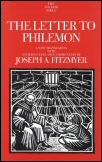
The apostle Paul’s letter to his friend and fellow Christian Philemon, which focuses on the question of slavery, has long inspired debate. Onesimus, one of Philemon’s slaves, has left his master’s house and sought refuge with Paul, during which time he has converted to Christianity. In a letter to Philemon, Paul assures his friend that he is sending Onesimus back, but pleads for mercy on the slave’s behalf, asking Philemon to treat him as a beloved brother and as he would treat the apostle himself.
Examining Paul’s letter within the context of the social, political, and economic realities of the time, Joseph A. Fitzmyer sheds light on the question of whether Paul was suggesting that Onesimus be granted freedom from slavery or whether he was simply advocating a lenient treatment of Onesimus. His insights not only clarify Paul’s position but show why the letter is relevant in the Church today.
Joseph A. Fitzmyer is a Jesuit priest and professor emeritus at the Catholic University of America. A past president of both the Society of Biblical Literature and the Catholic Biblical Association, and co-editor of The New Jerome Biblical Commentary, Fitzmyer has written The Aramaic Inscriptions of Sefire and The Genesis Apocryphon of Qumran Cave 1 (1Q20): A Commentary, available from Logos in the Northwest Semitic Collection (7 vols.), and A Manual of Palestinian Aramaic Texts.
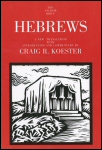
One of early Christianity’s most carefully crafted sermons, Epistle to the Hebrews addresses listeners who have experienced the elation of conversion and the heat of hostility, but who now must confront the formidable task of remaining faithful in a society that rejects their commitments. The letter probes into the one of most profound questions of faith: If it is God’s will that believers be crowned with glory and honor, why are the faithful subject to suffering and shame? Through the stories of Abraham and Sarah, Moses, and Rahab, whose faith enabled them to overcome severe trials and conflicts, and through the story of Jesus himself, whose sufferings opened the way to God’s presence for all, the sermon confirms the foundations of the Christian faith.
In a magisterial introduction, Craig R. Koester presents a compelling portrait of the early Christian community and examines the debates that have surrounded Epistle to the Hebrews for two millennia. Drawing on his knowledge of classical rhetoric, he clarifies the book’s arguments and discusses the use of evocative language and imagery to appeal to its audience’s minds, emotions, and will. Providing an authoritative, accessible discussion of the book’s high priestly Christology, this landmark commentary charts new directions for the interpretation of Epistle to the Hebrews and its influence on Christian theology and worship.
Craig R. Koester is professor of New Testament at Luther Seminary in St. Paul, Minnesota. He is the author of Symbolism in the Fourth Gospel, The Dwelling of God, and Revelation and the End of All Things, as well as numerous articles for scholarly and professional journals.
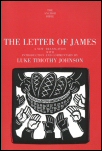
The letter of James is one of the most significant, yet generally overlooked, New Testament books. Because Martin Luther, leader of the Protestant Reformation, disliked this letter for its emphasis on good deeds, the book has come to be viewed as being in opposition to Paul’s letters, which emphasize faith in God. To correct these and other misconceptions about James, Luke Timothy Johnson embarks on an unprecedented history of the interpretation of this pivotal letter, highlighting the vast appreciation for James over the centuries.
Johnson boldly identifies the first-century author as none other than James, the brother of Jesus Christ. While modern skepticism casts doubt on this conclusion, early textual witnesses, as well as saints and scholars throughout the centuries, corroborate Johnson’s position.
A thorough examination of the original-language texts and an explanation of the literary context of James help illuminate the original meaning of the letter. Johnson’s sensitivity to both the biblical text and the sensibilities of the modern reader, coupled with his convincing scholarly presentation, set this apart as one of the premier commentaries on James for present and future generations.
Luke Timothy Johnson is professor of New Testament at the Chandler School of Theology, Emory University, in Atlanta, Georgia. He is the author of The Letter of James in this series, The Writings of the New Testament, Reading Romans in Reading the New Testament Commentary (12 vols.), and of the bestseller The Real Jesus, as well as other books and numerous articles on the New Testament.
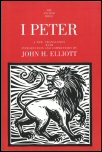
The significance of 1 Peter for the formation of Christianity stands in sharp contrast to its brevity. John H. Elliott, a leading authority on this letter, brings its significance to life in this magnificent addition to the renowned Anchor Yale Bible.
Elliott sets the letter into context, covering its literary, historical, theological, and linguistic elements. In detailed, accessible discussions, he draws on the latest research to illuminate the social and cultural influences on the church in its initial years. Treating such important Petrine concerns as living honorably in a hostile society, finding meaning in suffering, and resisting social assimilation as the elect and holy family of God, the translation, notes, and commentary in this volume will help readers appreciate the powerful and enduring message of this fascinating letter.
John H. Elliott is professor of theology and religious studies at the University of San Francisco, a Lutheran clergyman, and a co-founder of the Context Group. In addition to numerous publications on various New Testament writings, especially from a social-scientific perspective, his books on 1 Peter include The Elect and the Holy, A Home for the Homeless, and the commentary on 1–2 Peter and Jude in the Augsburg Commentary on the New Testament.

Jerome H. Neyrey gives us a thoroughly up-to-date and comprehensive study of two of the most obscure books of the New Testament. Written after the death of Jesus and his Apostles, the Epistles of 2 Peter and Jude offer a glimpse into the turbulent life of the early Christian communities. Neyrey’s fascinating study not only provides an entirely new translation of the two texts, but also stirring commentary that takes the reader inside groups located at the very edges of Christianity, in contact with the wider Roman world and Greek culture of the day.
Neyrey builds upon the excellent scholarship of the past, and introduces readers to the discussion factors that were rarely understood or considered in earlier times: the social, political, and economic setting in which the New Testament Epistles were written and read—the church as a community within the larger context of the vast Roman empire of the late first and early second centuries. And while these letters are often considered peripheral or marginal to the New Testament, they nevertheless reveal and interpret one of the murkier eras in the life of the church. They reflect the hard times and difficult circumstances of the faithful, beset by treacherous comrades within and malevolent enemies without. But all the while, these documents express the constancy and commitment of those who found salvation and the renewal of life in the one Lord, Jesus Christ.
Jerome H. Neyrey, a Jesuit priest, is professor of New Testament at the University of Notre Dame. He received his PhD from Yale University, is a past associate editor of the Catholic Biblical Quarterly, and is currently associate editor of the Biblical Theology Bulletin.
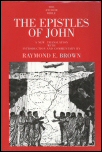
With this study—companion to the masterful two volume The Gospel According to John—Raymond E. Brown completed his trilogy on the Johannine corpus. Meticulous in detail, exhaustive in analysis, persuasive in argument, it examines controversies that have long troubled both biblical scholars and lay readers. Questions of authorship, composition, and dating, as well as the debate over source theories, are discussed at length; but these are kept subordinate to the overall question of meaning.
What gives this commentary special interest and excitement is the bold, imaginative reconstruction of the setting of the Johannine work—in particular of the “opposition figures,” who are only dimly sketched in the Epistles—so that we see clearly that the author is writing to his flock both about the dangers and difficulties confronting them, and about the eternal life that is theirs by the gift of God. In this way, the Epistles of John become intelligible as broadsides in a critical engagement between the forces of light and darkness.
In addition to his superb textual analysis of the letters, Raymond E. Brown has brought to life the community in which these works were formed and shaped. We are forcefully reminded that the Gospel and the Epistles were addressed to very real people living in the first century AD, people with religious problems not unlike our own. In all respects, The Epistles of John stands out as a model of biblical scholarship and study.
Raymond E. Brown was, throughout his illustrious career, internationally regarded as the dean of New Testament scholars. He was Auburn Distinguished Professor Emeritus of biblical studies at Union Theological Seminary in New York City. In addition to his commentary on John in the Anchor Yale Bible, he has also authored more than 35 books.
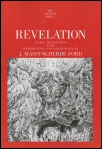
The book of Revelation, also called the Apocalypse of John, encourages Christians to be faithful to their Lord, Jesus Christ, through a rich mixture of symbolism and images. Perhaps the most puzzling book in all of Scripture, Revelation introduces bowls and scrolls, saints and angels, horsemen and beasts, the bride and the lamb, in a wondrous end-times drama. The scene shifts from cataclysmic battles to the climax of a new heaven and new earth. In the end, the reader is exhorted to heed the words of this stunning prophecy.
J. Ford addresses the seemingly infinite questions surrounding the book of Revelation. Issues of authorship, date, literary composition, theology, audience, purpose, and the meaning of John’s now obscure symbolism occupy Ford throughout. Traditionally, Revelation is the final New Testament book, but its theology, imagery, and historical content suggest it might be the transitional link between the Hebrew Bible and the New Testament. Contrary to general scholarly opinion, Ford identifies the writer as the Hebrew prophet and forerunner of Jesus, John the Baptist, not John the Evangelist. She conjectures that the Baptist spread his fiery apocalyptic visions decades before the first Gospels were completed.
Along with a fresh new translation of the book, the author’s insightful commentary and unique conclusions make for captivating reading. In light of both ancient writings and recent archaeological discoveries, Ford shows what this baffling work meant to first-century believers, and what it means for Christians today.
J. Massyngberde Ford is professor of New Testament studies at the University of Notre Dame in Indiana.

Revelation: A New Translation with Introduction and Commentary
- Author: Craig R. Koester
- Publisher: Yale University Press
- Publication Date: 2014
- Pages: 923
In this landmark commentary, Craig R. Koester offers a comprehensive look at a powerful and controversial early Christian text, the book of Revelation. The author provides richly textured descriptions of the book’s setting and language, making extensive use of Greek and Latin inscriptions, classical texts, and ancient Jewish writings, including the Dead Sea Scrolls. Rather than viewing Revelation as world-negating, Koester focuses on its deep engagement with social, religious, and economic issues while addressing the book’s volatile history of interpretation. The result is a groundbreaking study that provides bold new insights and sets new directions for the continued appreciation of this text.
Contents
- History of Interpretation and Influence
- Historical Issues
- Social Setting of Revelation
- Literary Aspects
- Rhetorical Aspects
- Text of Revelation
Craig R. Koester is vice president of academic affairs and professor and Asher O. and Carrie Nasby Chair of New Testament at Luther Seminary in St. Paul, Minnesota. He received his PhD in New Testament from Union Theological Seminary in New York.
Reviews
3 ratings
Matthias Jonas Bühler
4/8/2025
The commentaries on Luke, Acts, Philemon, and John (both the Gospel and the Epistle) are outstanding. Especially the works of Brown and Fitzmyer are scientifically top-notch. Brown’s historical reconstruction of 1 John is a classic in the field of commentaries and secondary literature.I can highly recommend the Anchor Yale Bible Commentary Series. They all follow the same structure: a translation of the biblical text, notes, and comments, as well as a bibliography at the end of each section. Because of this segmentation, the content can be somewhat repetitive, but it remains a wonderful resource.Anatolii Tsoniev
8/30/2024
Dr. Anthony Mazak
6/27/2021
Samuel Bauer
4/30/2021